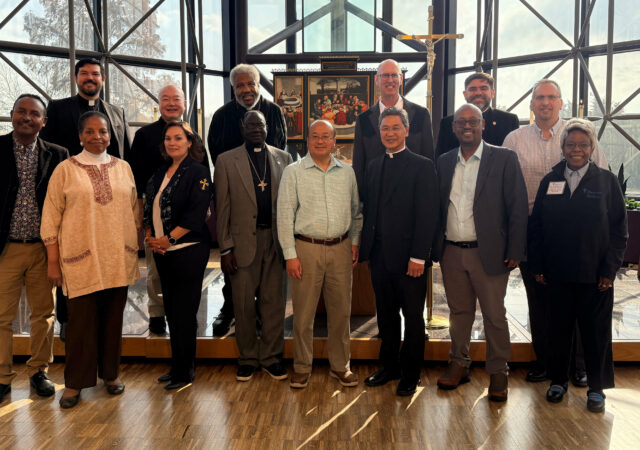By Joe Isenhower Jr. and Elizabeth M. Truong
ST. LOUIS — The LCMS Boards for National and International Mission heard reports of priorities from Synod mission executives and continued their primary work of developing policies during their Feb. 3-4 meeting here.
As the boards’ joint session got under way, Synod President Rev. Dr. Matthew C. Harrison introduced the Rev. Gregory K. Williamson, who was installed in January as the Synod’s first chief mission officer. “He’s a quick study,” Harrison said of Williamson.
Williamson, who comes from a military background, told the boards, “There are many pockets of excellence in the LCMS. We need your help in strategic planning to connect them. … It’s great to be with President Harrison and [other Synod leaders] as we preach with boldness the Gospel and also connect mission and works of mercy.”
“Let us not underestimate our relatively small numbers,” Williamson said. “This is a church body with the right message, at the right time, heading in the right direction.”
Later, during the boards’ separate business sessions, Williamson shared five “values” and six “mission priorities” recently developed by the LCMS Office of the President.
The values that will guide the work of the boards and offices, as worded on a handout prepared for the BNM meeting, are as follows:
- Fidelity — be Lutheran;
- Quality — the pursuit of excellence;
- Credibility — inspires belief in project;
- Sustainability — financial capacity to last; and
- Stability — strength to stand and endure.
That handout also lists the six priorities for the Office of National Mission, which Williamson described as “pillars for our Synod’s “Witness, Mercy, Life Together” emphasis.” In the order of their importance, they are:
1. Plant, sustain and revitalize distinctly Lutheran churches.
2. Support and expand theological education.
3. Perform human care in close proximity to Word-and-sacrament ministry.
4. Collaborate with the Synod’s members and partners to enhance mission effectiveness.
5. Nurture pastors, missionaries and professional church workers to promote spiritual, emotional and physical well-being.
6. Enhance elementary and secondary education, and youth ministry.
The Office of International Mission has six similar priorities related to international witness and mercy work.
Williamson also stressed to both boards the need to “think globally.”
“I want you to encourage folks to think globally … wherever they are. [Mission] is global. Please instill that in the minds of the people with whom you work every day.”
He emphasized that the Synod “has capacity” for global mission.
“Let’s be who we are,” he said in the Board for International Mission (BIM) meeting. “We know how to be confessional, evangelical Lutherans. We’ve been that for a long, long time. Let’s preach the Gospel, teach and administer the sacraments — faithfully and globally.”
BNM meeting
The Rev. Bart Day, executive director of the LCMS Office of National Mission (ONM), told the Board for National Mission (BNM) that the new values and priorities that Williamson presented “will work beautifully with what we do. Everything will be much more alive, fluid and structured.”
Day highlighted for the BNM three of 10 different efforts that the ONM is making to better align support of district ministries. They are:
1. Define how each ONM program is designed to relate to districts;
2. Work with district representatives to create a program review process that will help maintain alignment; and
3. Create a strategy and framework for providing networking and resources to the church.
Day indicated that these efforts, along with others to be reviewed at future BNM meetings, emerged from discussions with district presidents, mission executives and others at the Synod’s National Mission Conference last fall.
BNM Chairman Rev. Steven C. Briel thanked Day for this work and emphasized, “we want the Synod to know that this board takes them most seriously.”
Day also pointed out that in applying what it does on behalf of districts, the ONM will “adapt its assets to fit three demographic mission paradigms” — in rural/small-town settings, in urban settings and in suburban settings. He indicated that in most cases, those assets could be delivered by deployed Synod staff members who are available to help districts in those settings.
“This model forces us beyond the one-size-fits-all approach,” Day said, “instead customizing resources so that they will work best where needed most.”
BIM business
During its separate meeting, the Board for International Mission (BIM) focused on its “boundaries, principles and parameters” of the policies that will guide the work of the LCMS Office of International Mission staff and missionaries.
The BIM approved 15 sections of drafted “ends” policy and principles, with drafts of two other such sections still in process.
A chart in the board’s docket defines ends as “the desired results” and describes principles as essential characteristics and activities of the office that are needed to achieve the desired ends.
The BIM also decided to request that Williamson and other staff members develop the means — how to achieve those ends.
The policies already developed relate to such areas as safeguarding the mutual rights of partner churches and the LCMS; the OIM serving as a liaison between missionaries and/or partner churches and the LCMS colleges, universities and seminaries; human care work; military chaplaincy work; international schools; having strong missional leadership; and training and preparing missionaries.
Also discussed in the BIM meeting were relationships with partner churches, relationships and accountability between the OIM and LCMS districts or individual congregations and caution in establishing policies that are neither too narrow nor too broad — so that they are as useful as possible for the OIM and LCMS missionaries.
“A lot of relationships [between partner churches and LCMS districts or congregations] take place without the knowledge of OIM and relationships become very complicated,” said BIM member the Rev. John Temple. “The Synod presence in a particular area gets very confused. Somehow, we have to talk about that.”
The Rev. Dr. Albert B. Collver III, LCMS director of Church Relations — assistant to the president, informed the board that he has had many positive conversations with district presidents about relationships that have been established between pastors and/or congregations from their districts and churches in other countries.
The BIM also approved several definitions related to international mission work.
One of those states that an LCMS missionary is “inclusive of those persons who are either called as a Minister of Religion — Ordained or Minister of Religion — Commissioned or are appointed as a worker for the ministries in foreign areas by the Board for International Mission or assigned as a worker for the ministries in foreign areas by the Office of International Mission.”
That definition is intended to be in accord with the Synod Handbook and was slightly extended to “reflect current practice,” according to Collver.
A partner church, which may have been used interchangeably in the past with “sister church,” is defined as a church with whom the LCMS is in full altar and pulpit fellowship. Some partner churches may have come into being through LCMS-supported mission efforts, while others have other beginnings.
BIM Vice-Chairman John Edson noted, “Partner churches are defined in the [LCMS] Bylaws, but people have used ‘partner churches,’ ‘sister churches’ and ‘associated churches’ in sometimes-equal terms. We want to eliminate confusion.”
An associated church, as defined by the board, is a non-partner church with which the LCMS is in a relationship, perhaps through a memorandum of understanding or a working agreement.
Current examples of LCMS associated churches include the Silesian Evangelical Church of the Augsburg Confession in the Czech Republic and the Ethiopian Evangelical Church Mekane Yesus in Ethiopia.
The Rev. Dr. David Birner and the Rev. John Fale, interim co-executive directors of the OIM, provided a joint update to the board on the progress of merging the program staff that formerly composed LCMS World Mission and LCMS World Relief and Human Care.
“In the last 18 months, Dave [Birner] and I have had a really good working relationship and we recognize that God has brought these gifts to this time and this place to complete our work rather than compete among our work,” said Fale.
Other reports
In joint sessions, the board heard a number of other reports, including a summary of developments in the Synod from Harrison and a financial update from LCMS Executive Director of Accounting Charles Rhodes.
The Rev. Dr. Jeffrey Gibbs, professor and chairman of the Department of Exegetical Theology at Concordia Seminary, St. Louis, led the boards in the theological study on witness, titled “The Church’s Calling of Witness: Filling in the Blanks.”
He said that “witness [marturia] is a rich and flexible” word, “with a variety of blanks around it that can be filled in variously.”
Gibbs suggested that “the most important blank to fill in is the ‘what.’ What is the content of the witness, the testimony that is being given?”
The “what,” he said, is “Jesus Christ, Jesus Christ in His rich fullness,” and “Jesus Christ in death … and in resurrection.”
Gibbs cited the apostolic witness presented throughout the first 10 chapters of Acts, concluding that it “gives primacy and emphasis to the resurrection of Jesus, and it gives us a beautiful and powerful way to ‘fill in the blanks’ of our witness to Jesus.”
Elizabeth M. Truong is a staff writer with LCMS Communications.
Posted March 2, 2012




